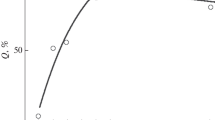Synopsis
If an individual is less susceptible to predation in a group it should be able to reduce its vigilance for predators and perhaps also its tendency to flee from predators, thereby gaining time and energy for feeding and other activities. These predictions were examined in the field (Veronica Lake, northwestern Ontario) using a facultative schooling species, the spottail shiner (Notropis hudsonius). Schools of various sizes ‘attacked’ with a fish predator model had a significantly lower reaction distance to the predator than solitary shiners. Solitary shiners must therefore invest more time and energy in defense but may gain a feeding advantage because their visual field does not overlap with conspecific competitors.
Similar content being viewed by others
References cited
Alexander, R.D. 1974. The evolution of social behavior. Ann. Rev. Ecol. Syst. 5: 325–383.
Berger, J. 1978. Group size, foraging, and antipredator ploys: an analysis of bighorn sheep decisions. Behav. Ecol. Sociobiol. 4: 91–99.
Bertram, B.C.R. 1978. Living in groups: predators and prey. pp. 64–96. In: J.R. Krebs & N.B. Davies (ed.) Behavioural Ecology: An Evolutionary Approach, Sinauer, Sunderland.
Brown, J.L. 1975. The evolution of behavior. W.W. Norton Co., New York. 761 pp.
Carl, E.A. 1971. Population control in arctic ground squirrels. Ecology 52: 395–413.
Eggers, D.M. 1976. Theoretical effect of schooling by planktivorous fish predators on rate of prey consumption. J. Fish. Res. Board Can. 33: 1964–1971.
Hamilton, W.D. 1971. Geometry for the selfish herd. J. theor. Biol. 31: 295–311.
Hamilton, W.J., III, R.E. Buskirk & W.H. Buskirk. 1978. Omnivory and utilization of food resources by chacma baboons, Papio ursinus. Amer. Natur. 112: 911–924.
Hobson, E.S. 1978. Aggregating as a defense against predators in aquatic and terrestrial environments. pp. 219–234. In: E.S. Reese & F.J. Lighter (ed.) Contrasts in Behavior, John Wiley & Sons, New York.
Hoogland, J.L. 1979. The effect of colony size on individual alertness of prairie dogs (Sciuridae:Cynomys spp.). Anim. Behav. 27: 394–407.
Hoogland, J.L. & P.W. Sherman. 1976. Advantages and disadvantages of bank swallow (Riparia riparia) coloniality. Ecol. Monogr. 46: 33–58.
Hunter, J.R. 1966. Procedure for analysis of schooling behavior. J. Fish. Res. Board Can. 23: 547–562.
Keenleyside, M.H.A. 1955. Some aspects of the schooling behaviour of fish. Behaviour 8: 183–248.
Kenward, R.E. 1978. Hawks and doves: factors affecting success and selection in goshawk attacks on woodpigeons. J. Anim. Ecol. 47: 449–460.
Lazarus, J. 1978. Vigilance, flock size and domain of danger size in the white-fronted goose. Wildfowl 29: 135–145.
Lazarus, J. 1979. The early warning function of flocking in birds: an experimental study with captive quelea. Anim. Behav. 27: 855–865.
Lazarus, J. & I.R. Inglis. 1978. The breeding behaviour of the pink-footed goose: parental care and vigilant behaviour during the fledging period. Behaviour 65: 62–88.
Major, P.F. 1978. Predator-prey interactions in two schooling fishes,Caranx ignobilis andStolephorus purpureus. Anim. Behav. 26: 760–777.
McKaye, K.R., D.J. Weiland & T.M. Lim. 1979. Comments on the breeding biology ofGobiomorus dormitor (Osteichthyes: Eleotridae) and the advantage of schooling behavior to its fry. Copeia 1979: 542–544.
Milinski, M. 1977. Experiments on the selection by predators against spatial oddity of their prey. Z. Tierpsychol. 43: 311–325.
Moss, R.E. 1979. Miller's Law and the clustering of prey. Unpublished manuscript. 26 pp.
Neill, S.R. St.J. & J.M. Cullen. 1974. Experiments on whether schooling by their prey affects the hunting behaviour of cephalopods and fish predators. J. Zool (Lond.) 172: 549–569.
Nursall, J.R. 1973. Some behavioral interactions of spottail shiners (Notropis hudsonius), yellow perch (Perca flavescens), and northern pike (Esox lucius). J. Fish. Res. Board Can. 30: 1161–1178.
Powell, G.V.N. 1974. Experimental analysis of the social value of flocking by starlings (Sturnus vulgaris) in relation to predation and foraging. Anim. Behav. 22: 501–505.
Radakov, D.V. 1973. Schooling in the ecology of fish. John Wiley & Sons, New York. 173 pp.
Rubenstein, D.I. 1978. On predation, competition, and the advantages of group living. pp. 205–231. In: P.P.G. Bateson & P.H. Klopfer (ed.) Perspectives in Ethology, Plenum, New York.
Shaw, E. 1978. Schooling fishes. Amer. Sci. 66: 166–175.
Siegfried, W.R. & L.G. Underhill. 1975. Flocking as an antipredator strategy in doves. Anim. Behav. 23: 504–508.
Smith, J.N.M. 1977. Feeding rates, search paths, and surveillance for predators in great-tailed grackle flocks. Can. J. Zool. 55: 891–898.
Wilson, E.O. 1975. Sociobiology: the new synthesis. Harvard Univ. Press, Cambridge. 697 pp.
Author information
Authors and Affiliations
Rights and permissions
About this article
Cite this article
Seghers, B.H. Facultative schooling behavior in the spottail shiner (Notropis hudsonius): possible costs and benefits. Environ Biol Fish 6, 21–24 (1981). https://doi.org/10.1007/BF00001795
Received:
Accepted:
Issue Date:
DOI: https://doi.org/10.1007/BF00001795




